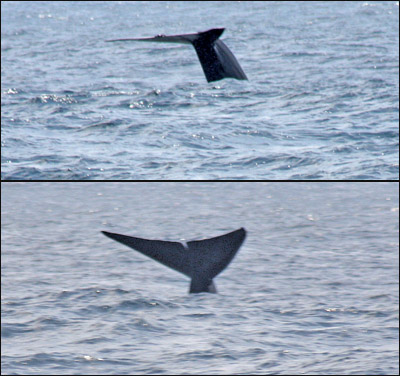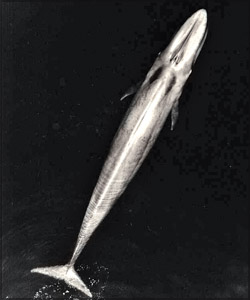
Spotting the blues
Sachitra MAHENDRA
Watching blue whales, Balaenoptera musculus, of course, may not give
the edgy observer a whale of a time. You should put up with the heated
sun, and the still waters of the ocean. If you ride on a boat, or a
small vessel, you should stay in one place and should be patient enough
to stay long to spot a movement of this largest mammal.
  Blue
whale watching industry is an internationally acclaimed adventure.
Research has been done on blue whales in the northern Indian Ocean,
closer to which Sri Lanka is located especially in areas like Devondra,
Galle and Kirinda. Blue
whale watching industry is an internationally acclaimed adventure.
Research has been done on blue whales in the northern Indian Ocean,
closer to which Sri Lanka is located especially in areas like Devondra,
Galle and Kirinda.
Ceylon Fisheries and Harbours Corporation (CFHC) has taken a decision
to gear this as a tourist attraction project, with all facilities and
equipment coming under the purview of ministry of fisheries and aquatic
resources.
CFHC team has been researching to prove the existence of blue whales
on the sea close to the country. Quite luckily they have spotted the
blue whales all 26 times they have been to sea.
According to CFHC Deputy General Manager Ayesh Ranawaka, blue whale
watching has brought good fortune for many traders.
“We do not encourage traders taking passengers out into deep sea to
watch blue whales. Going deep into sea itself is a risky exercise. We
are going to introduce amendments to the fisheries act to rule that no
such trading is allowed without the license of CFHC. This is to ensure
passenger safety.”
  The
passengers should wear life jackets and they are given Avomin, an
anti-nauseam tablet, along with marine guides on a fully equipped vessel
or boat. The
passengers should wear life jackets and they are given Avomin, an
anti-nauseam tablet, along with marine guides on a fully equipped vessel
or boat.
Far deep into the ocean blue whale watching is not a zoo-experience.
Blue whales do not show up at your beck and call. You have to practice
patience with your cameras on for a sudden appearance of the creature.
They make fast movements, even a camera sometimes isn’t able to capture
the move.
“If one of the passengers shows a sign of sickness, we will be
cruising back. No matter what, passenger safety is more important.” O
Roopasinghe, a marine guide said.
As Roopasinghe says, any passenger with a feeling of nausea is
instructed to look at a distance avoiding closer views.
“Sometimes, passengers get scared, when we are in the middle of the
sea. As the vessel plunges most of the time, we do not recommend too
much of water. Other beverages are alright.” Roopasinghe said.
The vessel never gets closer to where blue whales are, as the engine
sound scares off the sea mammal. The engine is on neutral on such
occasions.
The blue whale’s long thin body appears extended when they make
movements. When it breathes, this largest animal, believed to have ever
lived on earth, lifts the shoulder and blowhole. Its flat and U-shaped
head and the amazing ridge runs from the blowhole to the top of the
upper lip.
|

Flensing a blue whale |
|

Ayesh Ranawana making public awareness. |
Whales have many kinds of species, though blue whales are the
largest. However hard it was to hunt the blues, they were largely
victims of whalers before it was banned by International Whaling
Commission. The blues are today considered an endangered species.
According to American Cetacean Society Fact Sheet, a blue whale will
be crushed by its own weight without the support of large heavy bones.
Because of the support from the water, this sea animal does not need the
support of heavy bones.
Availability of excess food in the depth of sea makes the blues reach
an enormous size. They make sounds that can be felt too let alone
hearing. The sounds are said to be travelling a long distance through
water, allowing inter-communication among blues.
The blues are one of the rorquals, any of several baleen whales of
the family having longitudinal grooves on the throat and a small,
pointed dorsal fin. The baleen whales are also called whalebone whales
or great whales.
Blue Whales most commonly live alone or with one other individual. It
is not known whether those that travel in pairs stay together over long
periods or form more loose relationships.
loose relationships.
In locations where there is a high concentration of food, as many as
50 Blue Whales have been seen scattered over a small area. However, they
do not form the large close-knit groups seen in other baleen species.
The longest blue whale ever recorded was a 108-foot adult female
caught during whaling efforts in Antarctica! In modern times, blue
whales in the Southern Hemisphere reach lengths of 90-100 feet, but
their Northern Hemisphere counterparts are smaller, on average 75 to 80
feet (23 to 24.5 m).
Blue whales can weigh over 100 tons (99,800 kg). Females are larger
than males of the same age, the largest perhaps weighing as much as 150
tons (136,000 kg).
Blue whales are said to live in all oceans in the world. As research
maintains, the blues are sexually strong when they reach 6-10 years.
They travel to humid areas during winter months to mate.
These fast and strong swimmers are normally found in pairs, though
sometimes seen in solitude.
The colour of the blues is normally blue-gray. The underside of its
flipper and ventral of the fluke are white and dark respectively. They
consume diatoms, a microorganism in cold waters, which makes its
underside of the body yellowish green, earning it the nickname, ‘sulphur
bottom’
Pictures by Chaminda Hittetiya
|

